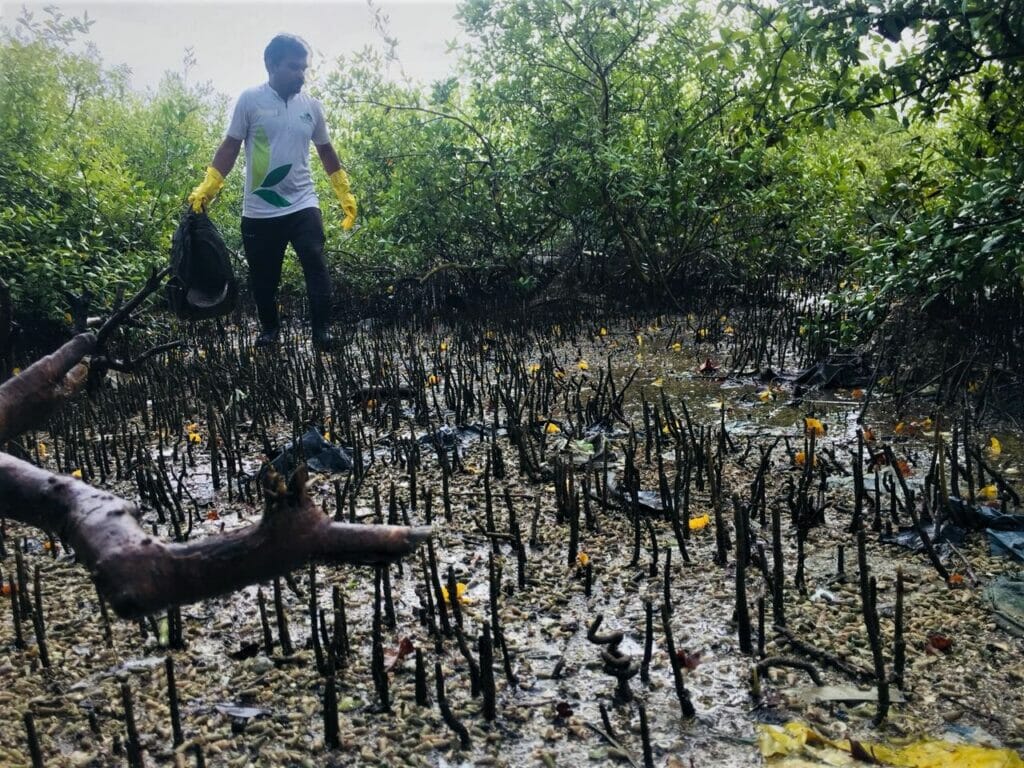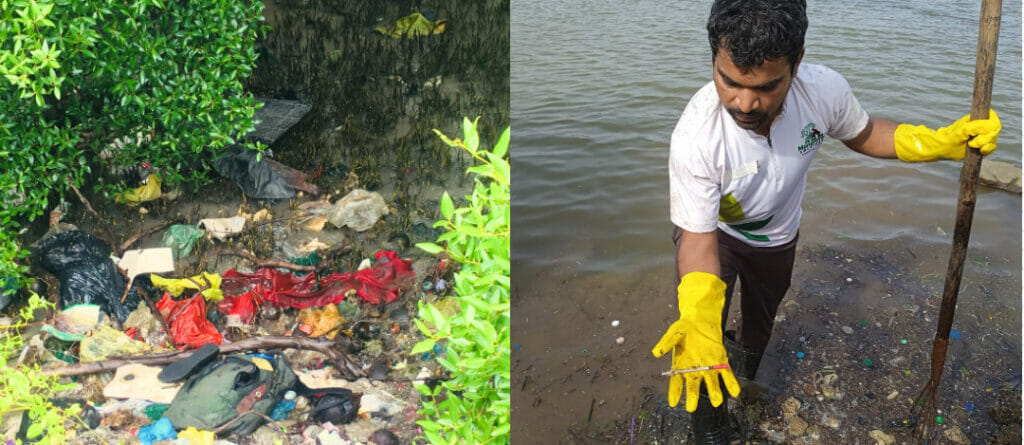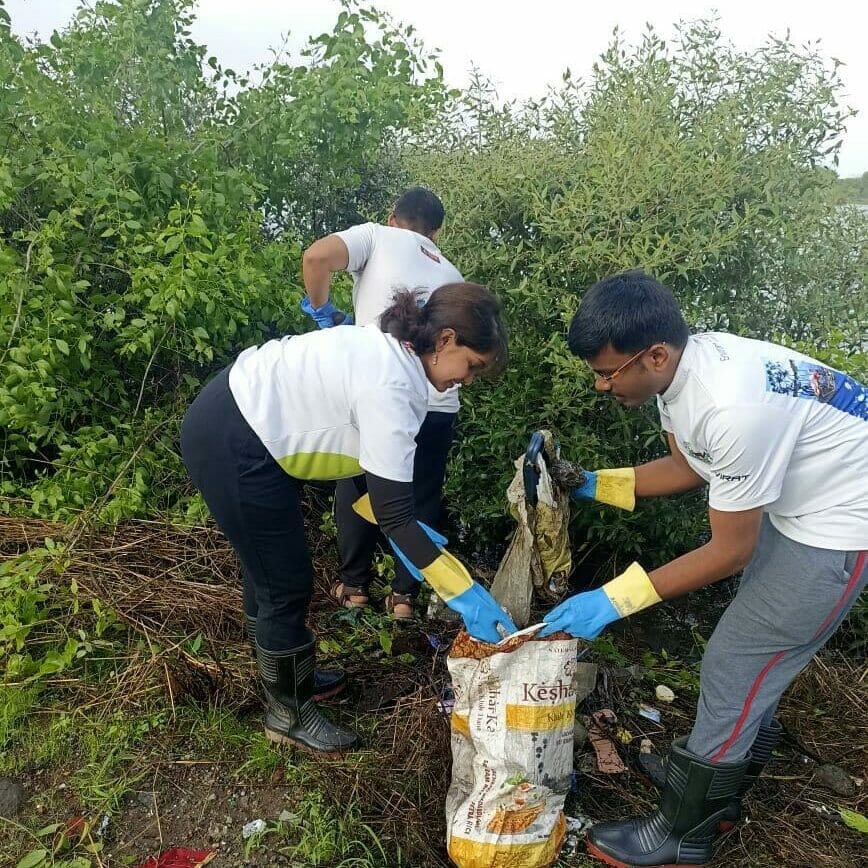Three years ago, when Dharmesh Barai moved to his new residence in Nerul, Navi Mumbai, he received a interesting tip from a friend. The friend informed him about a mangrove stretch, near Flamingo Point, in Seawood, Navi Mumbai, renowned for its annual congregation of migratory birds. Intrigued by the recommendation, Dharmesh, who held a deep affection for mangroves, decided to explore the place.
But what he encountered left him dismayed.
The once-pristine mangroves were entangled with knee-deep garbage, choking the delicate ecosystem. As a passionate nature lover, Dharmesh couldn’t bear to see such destruction. He knew that the city’s civic authorities do not clean up the garbage around the mangroves,
He decided to be proactive, that is, collect and clean the garbage that had been irresponsibly dumped and washed up at the mangroves.
He organised clean-up drives and awareness campaigns, along with his friends. He started a non-profit called Environment Life Foundation, to highlight the importance of preserving the fragile mangrove ecosystem. Armed with gloves, bags, and determination, Dharmesh and his team have spent countless hours over the past three years, removing over 250 tonnes of accumulated waste, painstakingly restoring the natural beauty of the mangroves in Navi Mumbai. The clean up drive has had a run of 150 weeks non-stop.

Importance of mangroves
Mangroves play a vital role in safeguarding shorelines against the destructive forces of storms, hurricanes, waves, and floods. With their intricate root systems, mangroves provide natural barriers that absorb and dissipate the energy of these powerful events, reducing the impact on coastal areas. Additionally, their roots stabilise sediments, helping to prevent erosion along shorelines.
Furthermore, mangroves contribute to the maintenance of water quality and clarity. They act as natural filters, trapping pollutants and preventing them from reaching coastal waters. Sediments originating from land are also captured by mangroves, preventing them from entering delicate marine ecosystems and negatively impacting water clarity.
Mangroves also play a crucial role as nurseries for fish and invertebrates, providing them with a safe space to grow and develop. These habitats offer abundant food sources and protection from predators.
The mangroves at Seawood are an essential breeding ground for crabs, explained Dharmesh. However, the presence of the massive garbage dump had devastated the ecosystem and crabs were not be seen. “Since the initiation of clean-up drives, the mangroves have begun bustling with life once again. The return of crabs shows a successful restoration of their breeding grounds,” he said.
Non-biodegradable garbage
The waste that accumulated at the mangroves predominantly consisted of non-biodegradable materials, including thermocol pieces, footwear, plastic bottles, liquor bottles, plastic bags and even medical waste.
Dharmesh says this garbage comes from areas like Dharavi and Mankhrud. It makes its way through various water bodies before reaching the mangroves. It is a severe threat to the mangroves’ health and longevity, as it gets entangled in their roots, slowly suffocating and killing them.
“It is disheartening to note that even hazardous medical waste, such as used syringes, is commonly found among the debris, highlighting the need for proper waste management and environmental awareness in the surrounding areas,” he adds.
He pointed out that the local government had not allocated any designated cleaning staff specifically for the removal of waste from the mangroves. It meant that the responsibility of clearing the debris fell upon citizens and volunteers who cared.

Right: Dharmesh Barai showing a used syringe, part of some of the commonly spotted medical waste at the mangrove forest. Pics: Sherine Raj
What was the solution?
Dharmesh and a few of his friends decided to clean up the mangroves by themselves.
After he posted photos and videos of their initial mangrove clean-up efforts on social media, the news reached the Navi Mumbai Municipal Corporation (NMMC) Deputy Commissioner, Dr. Babasaheb Rajale who personally reached out to Dharmesh and expressed his support for their initiative.
The bureaucrat actively joined the volunteers for a few clean-ups after their third week in 2020, boosting their efforts. “This unexpected collaboration not only provided a significant momentum to our cause but also garnered substantial local publicity, inspiring more individuals from the area to join the movement,” he said.
The involvement of Dr. Rajale, who joined the cause shows the impact that can be achieved through collaborative efforts between the civic governing body and the citizens of the area. This also helped in creating a ripple effect of community engagement and awareness during the initial stage of the NGO in 2020.
Since then, his team has been leading volunteers in weekly clean-up drives (mostly Sundays between 7 am to 9 am) at the mangrove forest without a single break for an impressive duration of 152 weeks.
Read more : Beach clean-up drives: Protecting the earth one step at a time
Growing number of volunteers
Dharmesh’s volunteer-driven initiative received enthusiastic response from citizens. Word spread and many joined hands for the clean up drives.
From its humble beginnings with just three friends, the NGO has had remarkable growth and now has over 30,000 dedicated volunteers.
Bhavya Poojary, a 27-year-old former corporate lawyer, who is now studying animal rights, spoke about transformation in her priorities after joining the NGO. Previously, like most people, Bhavya would indulge in late Sunday morning sleep-ins. But now, she wakes up early, dedicating two hours of her time for mangrove clean-up every week. “Together, we share a common purpose and are committed to the noble mission of conserving and protecting the mangroves,” she said.
Shivling Maynale, 26, a mechanical engineer, said, “After joining the NGO I saw the harsh reality of waste accumulation and its severe impact on the environment. I volunteer for this cause because I want to make a lasting impact and contribute to saving these invaluable coastal ecosystems.” He joined the NGO in 2021 through a friend and since then he makes an effort to be there for the clean-up every Sunday.
The rapid growth of the organisation has showcased the power of collective action and highlights the potential for positive change when like-minded individuals come together for a common cause.

Civic body’s responsibility to clean up
Mangroves hold significant importance in climate change mitigation, and the efforts of the NGO members in cleaning up the mangroves are commendable. However, it is crucial to address the root cause of the issue, which is the prevention of garbage entering the water bodies in the first place, says Executive Trustee, Conservation Action Trust, Debi Goenka, “While the volunteers are making a remarkable impact, the primary responsibility for cleaning up the garbage and preventing further waste accumulation lies with the civic body.”
According to Dharmesh, the garbage collected by the NGO gets transferred by the NMMC in trucks to the dumping ground where the waste gets segregated and processed.
Debi added saying that to effectively address this challenge, the civic body should take proactive measures such as installing nets at sewage outlets to trap solid waste before it enters the water bodies. “Additionally, hiring dedicated staff trained in professional garbage clean-up can ensure systematic and efficient removal of waste from the mangroves. The volunteers can play a supportive role by assisting or monitoring the work of these staff members, ensuring the process is carried out effectively,” he added.
By implementing these preventive measures and establishing a collaborative approach between volunteers and the civic body, the protection and cleanliness of the mangroves can be better ensured, explained Debi.
Future ahead
The collective effort to clean up the mangroves has gained significant traction, attracting participation from various NGOs, corporates, schools, and colleges. “Inspired by our mangrove clean-up movement, a group from Odisha, who were originally part of a plogging (jogging while picking up litter) group joined the cause and have now taken up the responsibility of cleaning up the Bhitarkanika mangrove forest in their own region,” said Dharmesh.
This cross-collaboration shows the widespread impact of the initial initiative, he says, as it encourages others to extend their efforts toward conserving mangroves in different areas. The collective involvement of different organisations and citizens has the potential for large-scale environmental awareness and action, he added.
The relentless efforts of Dharmesh and the volunteers, not only transformed the mangrove landscape of Seawood but has also instilled a sense of pride and responsibility within the citizens. His journey serves as a remarkable example of how a passionate individual can lead a grassroot movement, inspiring others to actively contribute to the betterment of their surroundings and safeguard the environment for future generations.
| Join the next mangrove clean-up drive Contact: 9773274296/ 8329213062 ienvironmentlife@gmail.com Location: Shiv Mandir, Karave Jetty, Opp- Jewel of Navi Mumbai, Near Palm Beach road, Nerul (West)- Navi Mumbai. Clean-Up Drive Google Location https://maps.app.goo.gl/33HAf9SrRm5aZTgs7 Note: Please carry your own water bottles and sturdy shoes. |